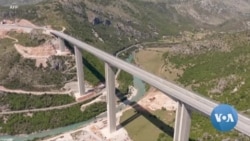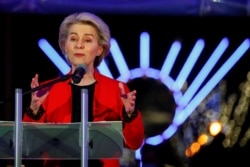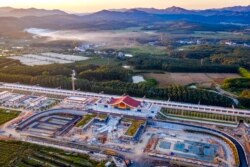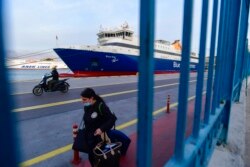The European Union this week launched a $340 billion "Global Gateway" fund to boost global infrastructure, which analysts say is aimed at rivaling China's Belt and Road Initiative. But can it compete with Beijing's billions?
The EU says its Global Gateway will finance high-quality digital, climate, and energy and transport infrastructure, including fiber-optic cables, road and rail, and renewable power, primarily in developing nations.
Green transition
"It will invest around the world to support our priorities — that is, the green and digital transition," European Commission President Ursula von der Leyen told a press conference on Wednesday.
"Think, for example, of investment in clean hydrogen. We have partner countries that have an abundance of renewable energy. Think of wind or solar to produce hydrogen, which is of interest for them as well as us, or think of underwater data cable connecting to continents," she told reporters. "Global Gateway will also focus on transport links, health care capacity … it will also support schools and education systems."
The fund will offer the equivalent of $340 billion through 2027, with the majority in loans rather than grants.
Democratic values
"We want to take a different approach. We want to show that a democratic, value-driven approach can deliver on the most pressing challenges. We want to show that it can on one hand meet local needs, but also, on the other hand, tackle the global challenges we have. And thus, in a way also, of course, benefit the European Union, because Global Gateway is also about our strategic interests around the world," von der Leyen said.
The project is also clearly about geopolitics, said analyst Jonathan Holslag, a professor of international politics at the Free University of Brussels.
"The European Commission obviously does not want to say so, but the main objective behind the Global Gateway is to respond to China's Belt and Road Initiative, China's new Silk Road," Holslag told VOA. "A lot of European companies have encountered huge competition from their Chinese rivals. They have also seen that countries are sliding into China's orbit."
Francesca Ghiretti, an analyst at Germany's Mercator Institute for China Studies, told VOA the European Union should be strategic about which projects it selects, but foresees investment headed toward Africa and India.
"We know so far Africa would be a big focus of Brussels, and probably also India, in light of the fact that in 2022 there are going to be two summits, one EU-Africa summit, and one EU-India summit," she said.
Chinese competition
Is Europe's $340 billion enough to compete with Beijing?
"Given the need for the development of infrastructure in every respect, whether it concerns railroads, ports and so forth, this is just a drop in the ocean, you could say," Holslag added. "But also, if you compare it to what China is investing, it remains rather small. China today has a total portfolio of overseas loans and credit of about 1,500 billion U.S. dollars."
That financial firepower was on show in Laos this week, as the country officially opened a $5.9 billion, 1,000-kilometer rail link with Kunming in China, which was 60% financed with Chinese state loans.
The railroad, which connects the Laotian capital, Vientiane, to the southern Chinese city through lush tropical mountains, is one of hundreds of projects launched under the Belt and Road Initiative to expand trade by building ports, railways and other facilities across Asia, Africa and the Pacific.
Debt
For some analysts, the costs of Chinese debt are dangerously high.
"The COVID situation doesn't augur particularly well for making money out of the railway, and that means more debt, and less revenue, less export," Greg Raymond of the Australian National University told The Associated Press.
"To me, when I look at the facts about Laos' economic situation, it's difficult to avoid the conclusion that they're slipping deeper into a kind of Chinese orbit simply because of the economic decisions that they've made," Raymond said.
China has also invested heavily in Europe, buying up ports including Piraeus in Greece — the EU's sixth-busiest container port — and financing transport routes in the Balkan states. Montenegro was recently forced to seek help from European and American banks to pay a $1 billion Chinese loan used to finance a new freeway.
European alternative
After watching Beijing move into its backyard, analysts say, the EU wants to offer an alternative. The EU said this week its "Global Gateway" program could work in conjunction with the United States' "Build Back Better World" infrastructure fund, launched alongside other G-7 members in June.
But Europe may not be competing on the same terms as China, said analyst Holslag.
"We also still have to see whether developing countries are interested in taking the conditions that are going to be attached to European loans, in terms of environmental sustainability, transparency and so forth. I think they will rather try to play off different donors against one another," Holslag told VOA.
China reaction
China denies the Belt and Road Initiative creates debt traps. Beijing has not yet responded directly to the European plans.
Responding to a question on the U.S. "Build Back Better World" fund, Chinese Ministry of Foreign Affairs spokesperson Wang Wenbin told reporters November 9, "There is plenty of room for cooperation in the field of global infrastructure, where different initiatives will not offset or replace each other. What the world needs is to build bridges instead of tearing them down, to be interconnected instead of decoupling, and to be mutually beneficial, not enclosed or exclusive."
Kris Cheng and VOA's Cantonese Service contributed to this report.














